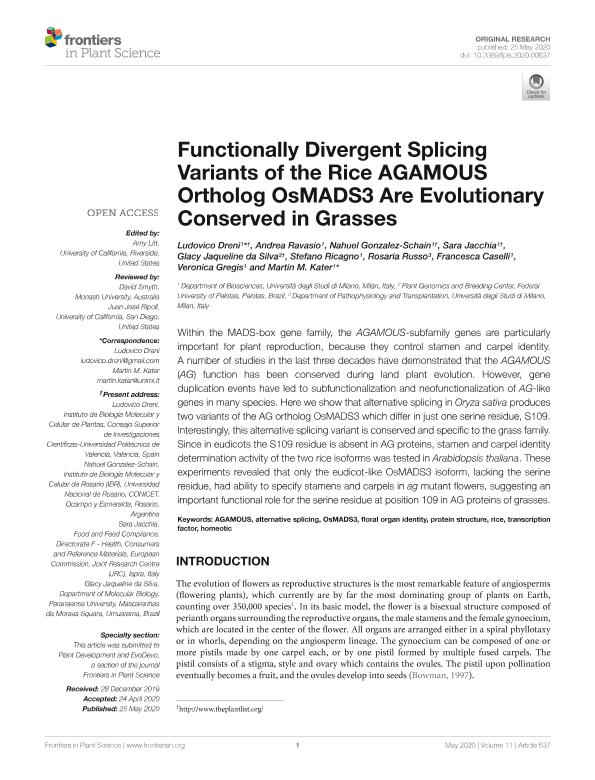Artículo
Functionally Divergent Splicing Variants of the Rice AGAMOUS Ortholog OsMADS3 Are Evolutionary Conserved in Grasses
Dreni, Ludovico; Ravasio, Andrea; Gonzalez Schain, Nahuel Damian ; Jacchia, Sara; da Silva, Glacy Jaqueline; Ricagno, Stefano; Russo, Rosaria; Caselli, Francesca; Gregis, Veronica; Kater, Martin M.
; Jacchia, Sara; da Silva, Glacy Jaqueline; Ricagno, Stefano; Russo, Rosaria; Caselli, Francesca; Gregis, Veronica; Kater, Martin M.
 ; Jacchia, Sara; da Silva, Glacy Jaqueline; Ricagno, Stefano; Russo, Rosaria; Caselli, Francesca; Gregis, Veronica; Kater, Martin M.
; Jacchia, Sara; da Silva, Glacy Jaqueline; Ricagno, Stefano; Russo, Rosaria; Caselli, Francesca; Gregis, Veronica; Kater, Martin M.
Fecha de publicación:
05/2020
Editorial:
Frontiers Media
Revista:
Frontiers in Plant Science
ISSN:
1664-462X
Idioma:
Inglés
Tipo de recurso:
Artículo publicado
Clasificación temática:
Resumen
Within the MADS-box gene family, the AGAMOUS-subfamily genes are particularly important for plant reproduction, because they control stamen and carpel identity. A number of studies in the last three decades have demonstrated that the AGAMOUS (AG) function has been conserved during land plant evolution. However, gene duplication events have led to subfunctionalization and neofunctionalization of AG-like genes in many species. Here we show that alternative splicing in Oryza sativa produces two variants of the AG ortholog OsMADS3 which differ in just one serine residue, S109. Interestingly, this alternative splicing variant is conserved and specific to the grass family. Since in eudicots the S109 residue is absent in AG proteins, stamen and carpel identity determination activity of the two rice isoforms was tested in Arabidopsis thaliana. These experiments revealed that only the eudicot-like OsMADS3 isoform, lacking the serine residue, had ability to specify stamens and carpels in ag mutant flowers, suggesting an important functional role for the serine residue at position 109 in AG proteins of grasses.
Archivos asociados
Licencia
Identificadores
Colecciones
Articulos(IBR)
Articulos de INST.DE BIOLOGIA MOLECULAR Y CELULAR DE ROSARIO
Articulos de INST.DE BIOLOGIA MOLECULAR Y CELULAR DE ROSARIO
Citación
Dreni, Ludovico; Ravasio, Andrea; Gonzalez Schain, Nahuel Damian; Jacchia, Sara; da Silva, Glacy Jaqueline; et al.; Functionally Divergent Splicing Variants of the Rice AGAMOUS Ortholog OsMADS3 Are Evolutionary Conserved in Grasses; Frontiers Media; Frontiers in Plant Science; 11; 5-2020; 1-16
Compartir
Altmétricas



